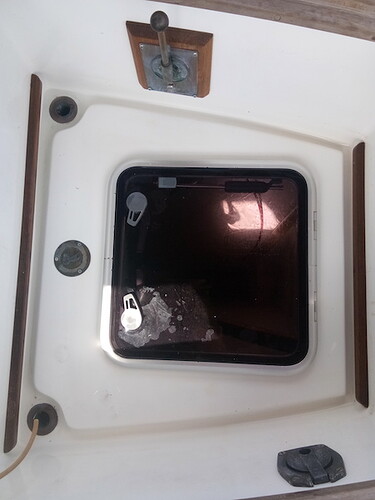Sorry for not replying earlier, Jonathan.
I must never photographed the equivalent area on Zygote. I seem to have nothing on hand to send. My search was fruitless. And I need to make the engine room spotless before my Big Boss will let me photograph it.
I’ll just talk about that area on Zygote. And that will explain why you’ve not received replies from owners of Sam L. Morse Co. boats.
- Protect the deep bilge
As you know, from the engine aft the deep bilge is both deep and narrow. The permanent resting place for nuts, bolts, washers and so on.
Z (and I assume other SLM Co boats) came with a nicely shaped long slab of marine ply, with cunningly chamfered edges and cut-outs to accommodate hoses (such as exhaust hose). The shape and the chamfer (or bevel, depending on which side of the river you were born) of the edges means that said slab of marine ply sits neatly over the deep bilge (and under the prop shaft). No cleats needed to support the slab. Shape, dimensions, and the angle of chamfer are everything.
Of course that slab (let’s call it the ‘deep bilge cover’ until someone can suggest something more nautical) is not infallible. Most anything that is 100% essential and not easy to replace seems naturally is able to evade the deep bilge cover and disappear until the day I turn the hull upside down.
When working in the engine room, I sometimes spread out an old towel to catch and hold runaways. Usually I only spread that old towel after I’ve just seen something disappear for the duration, uttered language unfit for the grandchildren, and whacked my head into the overhead.
- Do you not have access to the stuffing box and packing nut from the engine room?
On Z and all the SLM Co. boats in whose engine rooms I’ve crawled, access to the prop shaft from gearbox to shaft log, is from the engine room, not the lazarette.
I can guess your answer to that question. I can imagine how unfriendly it must be to do the acrobatics in the lazarette to do that.
I can only recount, as a warning, a story from one day at ScarbMarina: Glen (a middle-aged liveaboard) and CJ (a young liveboard who’d just bought a rusty hull and was passing his days hammering, grinding, and otherwise cutting out said rust and welding in new plates, meaning he was in excellent physical condition with broad shoulders and meaty muscles) were walking K dock and chatting. Glen heard a weak call for help. CJ had not.
Turns out a third liveaboard, a middle-aged male, had decided to accomplish a job in his bilge, work that required him to enter the bilge vertically and head down.
Too late, Liveaboard 3 discovered he could not exit from the bilge. His body had conformed to the shape of his bilge, his arms were below him - and his middle-aged hypertensive heart was filling his head and arms with blood and his lungs with fluid. Meaning he was about to discover the secret about which we talk little.
CJ, being young and strong, hauled on the legs and pulled the L3 into a horizontal position. Glen phoned the emergency paramedics. The paramedics took L3 away to hospital with sirens blaring and lights flashing. And guesstimated that were Glen and CJ to have walked K dock perhaps 20 minutes later, Glen would not have heard said weak call for help.
–
As well as having Z’s rudder in the workshop at the moment, I have her deep bilge cover in the cabin. I can show you next month, should you wish.
